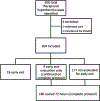Early exit from neonatal therapeutic hypothermia: A single institution experience using MRI to guide decision-making
- PMID: 32417801
- PMCID: PMC8477306
- DOI: 10.3233/NPM-200458
Early exit from neonatal therapeutic hypothermia: A single institution experience using MRI to guide decision-making
Abstract
Background: To evaluate the feasibility of a protocol using combined magnetic resonance imaging (MRI), clinical data, and electroencephalogram (EEG) to identify neonates with mild neonatal encephalopathy (NE) treated with therapeutic hypothermia (TH) who are eligible for "early exit".
Methods: Retrospective chart review of TH cases at a single Level III NICU over a 5-year period was used to describe the demographic, clinical, and outcome data in neonates that received early exit in contrast to 72 hour TH treatment.
Results: Two hundred and eight TH cases, including 18 early exit cases (9%) and 9 cases (4%) evaluated for early exit with MRI but continued on 72 hours of TH, were identified. Early exit and 72 hour treatment groups did not differ in demographics or cord gas measures, although early exit neonates had a shorter length of stay (p < 0.05). Consistent with the early exit protocol, no early exit infants had evidence of moderate or severe encephalopathy on EEG or evidence of hypoxic ischemic injury on MRI at 24 hours of life. Neurology follow up between age 1 and 18 months was available for 10 early exit infants, 8 of whom had a normal examination.
Conclusions: Early MRI at 24 hours of age, alongside clinical and EEG criteria, is feasible as part of a protocol to identify neonates eligible for early exit from therapeutic hypothermia.
Keywords: Neonatal encephalopathy; early exit; hypoxic ischemic encephalopathy; therapeutic hypothermia.
Conflict of interest statement
Disclosure statements
Drs. White, Grant, Soul, Inder, and El-Dib have no conflicts of interest or financial disclosures.
Similar articles
-
Therapeutic hypothermia in neonatal hypoxic ischemic encephalopathy: electrographic seizures and magnetic resonance imaging evidence of injury.J Pediatr. 2013 Aug;163(2):465-70. doi: 10.1016/j.jpeds.2013.01.041. Epub 2013 Feb 26. J Pediatr. 2013. PMID: 23452588
-
Therapeutic hypothermia for neonatal hypoxic-ischemic encephalopathy: magnetic resonance imaging findings and neurological outcomes in a Brazilian cohort.J Matern Fetal Neonatal Med. 2019 Aug;32(16):2727-2734. doi: 10.1080/14767058.2018.1448773. Epub 2018 Mar 13. J Matern Fetal Neonatal Med. 2019. PMID: 29504433
-
Association of cerebral activity with MRI scans in infants with neonatal encephalopathy undergoing therapeutic hypothermia.Eur J Pediatr. 2019 Jun;178(6):851-861. doi: 10.1007/s00431-019-03364-1. Epub 2019 Mar 21. Eur J Pediatr. 2019. PMID: 30900074
-
Current Practice of Therapeutic Hypothermia for Mild Hypoxic Ischemic Encephalopathy.J Child Neurol. 2019 Jun;34(7):402-409. doi: 10.1177/0883073819828625. Epub 2019 Mar 22. J Child Neurol. 2019. PMID: 30898007
-
Hypoxic ischemic encephalopathy and hypothermia: a critical look.Obstet Gynecol. 2005 Dec;106(6):1385-7. doi: 10.1097/01.AOG.0000190206.70375.b4. Obstet Gynecol. 2005. PMID: 16319267 Review.
Cited by
-
Regional variability in therapeutic hypothermia eligibility criteria for neonatal hypoxic-ischemic encephalopathy.Pediatr Res. 2024 Oct;96(5):1153-1161. doi: 10.1038/s41390-024-03184-6. Epub 2024 Apr 22. Pediatr Res. 2024. PMID: 38649726 Free PMC article. Review.
References
-
- Committee on Fetus and Newborn, Papile LA, Baley JE, Benitz W, Cummings J, et al.Hypothermia and neonatal encephalopathy. Pediatrics. 2014;133(6):1146–50. - PubMed
-
- Gluckman PD, Wyatt JS, Azzopardi D, Ballard R, Edwards AD, Ferriero DM, et al.Selective head cooling with mild systemic hypothermia after neonatal encephalopathy: multicentre randomised trial. Lancet. 2005;365(9460):663–70. - PubMed
-
- Shankaran S, Laptook AR, Ehrenkranz RA, Tyson JE, McDonald SA, Donovan EF, et al.Whole-body hypothermia for neonates with hypoxic-ischemic encephalopathy. N Engl J Med. 2005;353(15):1574–84. - PubMed
MeSH terms
Grants and funding
LinkOut - more resources
Full Text Sources
Medical


